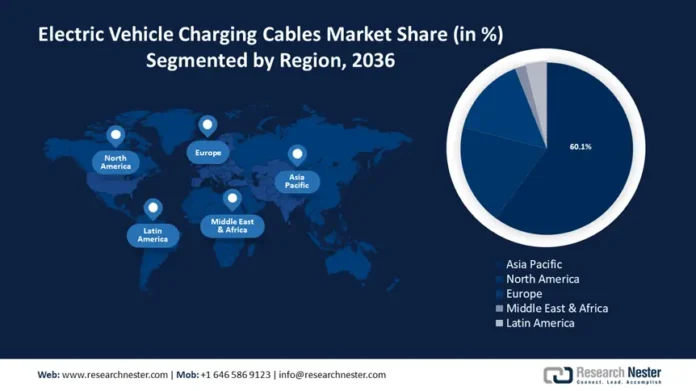The data published by International Energy Agency, by the year 2030, between 42% and 58% of car sales could be electric. Even in 2023, electric car market witnessed robust growth of 14 million car sale by the year 2023. Hence, as the espousal of electric vehicles is mushrooming globally, there is an increased demand for versatile and efficacious charging solutions.
In the quest to provide adequate charging facilities for electric vehicles, researchers are coming up with new ideas. One such notable innovation in this field is the electric vehicle charging cable, that is designed to safely deliver power from power source to the electric cars. For charging an EV, charging cables have become an essential part. Various prominent companies such as Tesla, General Cable Technologies Corporation, etc. are encashing huge profit margins. In this blog, we will delve deep into various aspects related to the EV charging cables market and why numerous companies are willing to invest in the domain.
What is an Electric Vehicle charging cable?
An electric vehicle charger cables are fabricated to adequately deliver power from the power source to the EV. A data published International Energy Agency states that by the end of the year 2022, there were 2.71 million public charging points installed globally.
Out of these, few of the charging stations operate with cables attached known as tethered charging stations. While other charging stations require the owner to bring their cables. Let us take a look on some of the prominent types of the EV charging cable:
| Types of EV charging cables | Features |
| Mode 1 charging cables | These cables simply connect light electric vehicles such as e-bikes, and scooters but not cars. In 2022, the number of e-bikes sold reached 36 million units, globally. |
| Mode 2 charging cables | These cable can plug into the EV on one end and connect ordinary 3 pin to domestic socket. This charging method is convenient and can deliver up to 2.3 kW of power. |
| Mode 3 charging cables | These cables are now the most common way to charge an EV across the globe. Also, these cables are standard in all across the world. |
| Mode 4 charging cables | These charging cables are fabricated to handle higher power outputs for fast charging. These cables are a bit heavier and can handle excess heat generated by higher power output. For instance, China is pioneering in EVSE deployment, with more than 85% of the world’s fast chargers. |
Hence, these electric vehicle charging cables are not just a channel to provide power but also progressing to meet the requirements of a diverse consumer base. Customers are relying on brands that are manufacturing state-of-the-art charging cables. Companies are also going through extensive research to meet the expectations such as,
- Usage of eco-friendly materials
- Increased durability and safety features of cables
- Faster charging capabilities
- Increased flexibility and cable length
Electric Vehicle Charging Cables Market Analysis:
The electric vehicle charging cables market size was over USD 1.51 billion in the year 2023. The market is further anticipated to accumulate USD 23 billion by the end of 2036, exhibiting a CAGR of 25.6%. Some of the factors acting as catalysts for the growth of the market are:
Sugre in development of private charging segment
Some of the prominent companies in the domain are TE Connectivity, ABB, Coroplast, Phoenix Contact, Dyden Corporation, Leoni AG, and BESEN International Group Co., Ltd.
Additionally, EV charging cables market in Asia Pacific is set to dominate the revenue share of over 60% by the year 2036. The growth of the market in the region can be attributed to rising government initiatives and the presence of a large consumer base.
Let us understand some of the regional and country highlights in the market:
- Rising development of high-speed charging infrastructure
- Exponential rise in adoption of electric vehicles
- Technological advancements in EV charging
- Sugre in development of private charging segment
Some of the prominent companies in the domain are TE Connectivity, ABB, Coroplast, Phoenix Contact, Dyden Corporation, Leoni AG, and BESEN International Group Co., Ltd.
Additionally, EV charging cables market in Asia Pacific is set to dominate the revenue share of over 60% by the year 2036. The growth of the market in the region can be attributed to rising government initiatives and the presence of a large consumer base.
Let us understand some of the regional and country highlights in the market:
China: The country accounts for almost 60% of all new electric car registrations. Other than this, Sinopec, which operated 21,100 charging points by the end of 2023, allocated USD 2.51 billion to its distribution segment.
United States: In 2021, Biden allocated USD 7.51 billion for establishing electric vehicle charging stations. Other than this, a local market player recently launched Brooklyn 718 cable. The charger is 2st EV charger with a detachable cable to meet the robust safety tests.
India: The country recently launched scheme to give tax rebate for electric vehicle companies. However, the condition is that they must have already invested USD 500 million.
In a nutshell,
The above information illustrates that the rising demand electric vehicles is making a pool of opportunities for the allied markets too. Subsequently, Electric vehicle (EV) charging cables market is set to garner significant revenue in the coming period of time. However, market players are required to understand the intricacies of the market to make sound business decisions.
Article written by: Utkarsha Deshpande







